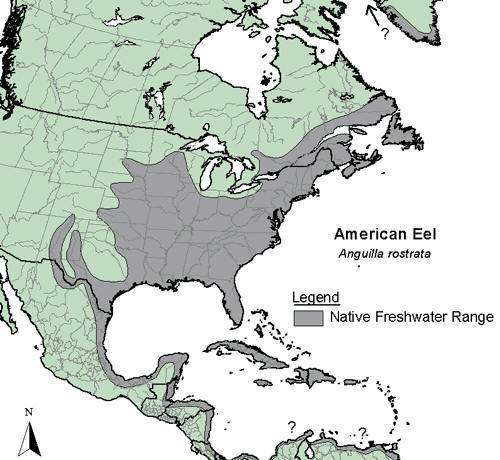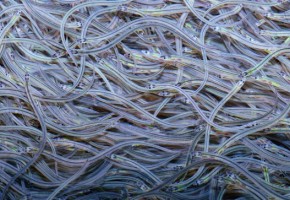Habitat
Anguilla rostrata has a
vast habitat in North America specifi cally
along the Atlantic coast all the way from Northern South America to
Greenland. (Krueger) They have such a peculiar distribution because of how
their life cycle. According to Oliveira, American Eels are catadromous which
means that they spend some of their life in freshwater and the other half of
their life in saltwater. This starts with the hatching of the eggs in the
Saragossa Sea. Which is just north of the Caribbean's. The eggs hatch and
are distributed by means of the Gulf Stream. When the larvae grow into
juveniles they move into the estuaries and streams.
cally
along the Atlantic coast all the way from Northern South America to
Greenland. (Krueger) They have such a peculiar distribution because of how
their life cycle. According to Oliveira, American Eels are catadromous which
means that they spend some of their life in freshwater and the other half of
their life in saltwater. This starts with the hatching of the eggs in the
Saragossa Sea. Which is just north of the Caribbean's. The eggs hatch and
are distributed by means of the Gulf Stream. When the larvae grow into
juveniles they move into the estuaries and streams.
In there juvenile they are considered to be glass eels (Jessop, et.
al.) and they move in these estuaries to grow and eat, they also make
another physical change in their appearance, pigmentation. This is for
protection and camouflageand to help them eat. According to Wang, when
pigmentation is developed in these eels the are considered to be elvers. At
this stage of life their growth is pretty rapid. This is when they start to
actually affect their ecosystem and their niche as a predator.

The niche of an Anguilla rostrata varies by its size
and the amount of development. According to Ogden the place on the food
chain a smaller Anguilla rostrata they usually feed on arthropod
larva such as Odonata and Plecoptera. But as the American
Eel grows its effect is greater being a predator of bigger organisms such as
small fish and crayfish. These are not the only things that are around the
juvenile eels as they grow the eel goes to deeper water (Helfman)to hunt and
to live so the organisms they have in their niche changes slightly.
In this deeper part of the freshwater estuaries they are known to be found
along with a lot more fish species such as white suckers (Castomus
commersoni) and the fallfish (Semotilus corporalis). Which are
considered to be bottom feeders and living on the bottom of the water will
be a major part of its habitat for the rest of its life. The Anguilla
rostatra fits in niche as a primary consumer it plays the role of an
intermediate predator.
But can are prey to bigger fish such as Atlantic Salmon (Salmo salar)
rest of its life. The Anguilla
rostatra fits in niche as a primary consumer it plays the role of an
intermediate predator.
But can are prey to bigger fish such as Atlantic Salmon (Salmo salar)
To learn about Form and Function click here
Home